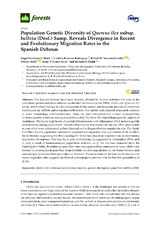Mostrar el registro sencillo del ítem
Population Genetic Diversity of Quercus ilex subsp. ballota (Desf.) Samp. Reveals Divergence in Recent and Evolutionary Migration Rates in the Spanish Dehesas
| dc.contributor.author | Fernández i Marti, Ángel | |
| dc.contributor.author | Romero-Rodríguez, M. Cristina | |
| dc.contributor.author | Navarro Cerrillo, Rafael M. | |
| dc.contributor.author | Abril, Nieves | |
| dc.contributor.author | Jorrín-Novo, Jesús V. | |
| dc.contributor.author | Dodd, Richard S. | |
| dc.date.accessioned | 2018-11-06T08:44:29Z | |
| dc.date.available | 2018-11-06T08:44:29Z | |
| dc.date.issued | 2018 | |
| dc.identifier.uri | http://hdl.handle.net/10396/17440 | |
| dc.description.abstract | The Spanish dehesas have been severely affected by human activities that date to the prehistoric period and have suffered accelerated decline since the 1980s. Holm oak (Quercus ilex subsp. ballota (Desf.) Samp.) is a key component of this system, and its acorns provide an important food source for wildlife and domesticated livestock. Our earlier work showed structured variation in acorn morphology and biochemistry. Here, we used chloroplast and nuclear microsatellites to detect genetic structure among populations of Q. ilex from the major biogeographic regions of Andalusia. We found high levels of spatial differentiation with chloroplast DNA indicating little seed dispersal among populations. Spatial differentiation was weaker for nuclear DNA, presumably as a result of more widespread pollen dispersal and its larger effective population size. The Baetic Cordillera (Cádiz) population consistently appeared well separated from populations of the northern Sierra Morena, suggesting that the Guadalquivir Valley has played an important role in determining population divergence. This may be, in part, evolutionary, as suggested by chloroplast DNA, and, in part, a result of human-induced population isolation, as Q. ilex has been removed from the Guadalquivir Valley. Evolutionary gene flow rates were greater than contemporary rates, which were limited to unidirectional gene flow from Córdoba to other populations in the Sierra Morena and, surprisingly, to the southern population at Almería. The inconsistency between evolutionary and recent migration rates suggests an effect of anthropogenic activity over the last few generations of Q. ilex. | es_ES |
| dc.format.mimetype | application/pdf | es_ES |
| dc.language.iso | eng | es_ES |
| dc.publisher | MDPI | es_ES |
| dc.rights | https://creativecommons.org/licenses/by/4.0/ | es_ES |
| dc.source | Forests 9(6), 337 (2018) | es_ES |
| dc.subject | Quercus ilex | es_ES |
| dc.subject | Dehesas | es_ES |
| dc.subject | Population structure | es_ES |
| dc.subject | Genetic divergence | es_ES |
| dc.subject | Gene flow | es_ES |
| dc.subject | nSSR | es_ES |
| dc.subject | cpSSR | es_ES |
| dc.title | Population Genetic Diversity of Quercus ilex subsp. ballota (Desf.) Samp. Reveals Divergence in Recent and Evolutionary Migration Rates in the Spanish Dehesas | es_ES |
| dc.type | info:eu-repo/semantics/article | es_ES |
| dc.relation.publisherversion | http://dx.doi.org/10.3390/f9060337 | es_ES |
| dc.relation.projectID | Gobierno de España. BIO2015-64737-R2 | es_ES |
| dc.relation.projectID | Gobierno de España. CGL2017-86161-R | es_ES |
| dc.rights.accessRights | info:eu-repo/semantics/openAccess | es_ES |

